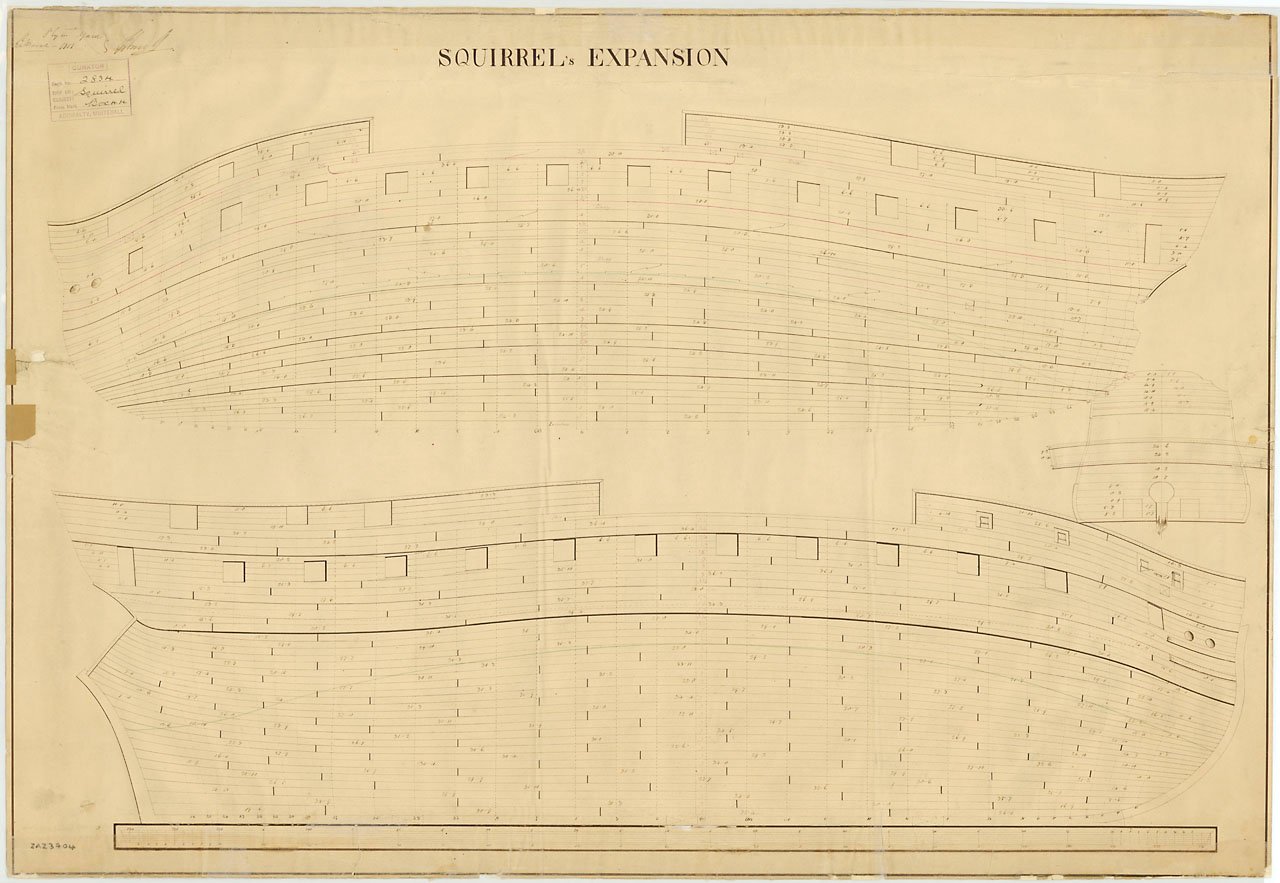-
Posts
8,149 -
Joined
-
Last visited
Content Type
Profiles
Forums
Gallery
Events
Everything posted by allanyed
-
Sounds like a great idea Gregory. Going a step further, once the outboard strakes are in place I wonder if anyone has successfully just cut them off altogether and used inboard quick work that is a little thicker than would normally be used. For example if the inboard planking is 2" thick, go to 4.25" thick (about 1.1mm at 1:100) Allan
-
Hi Tiziano, Your method of making the axles for the trucks is a new one for me and they look great. Did you try using an axle cutter first and then find this method better? Your method looks like something I think I will try on future projects. Ciao Allan
-
You are close 2.25X25.4 = 57mm. 57/100 = 0.57mm. There is no way the plywood bulkheads can be thinned and remain strong. Some folks cut them off and replace with something stronger like using plywood lying in a different direction or a good quality hardwood. In the end if you don't care about the bulkwarks being super wide go for it, but the cap rail may look odd. Look at scantlings for a 20 gun in the 1719 Establishment and it will help you a lot. Allan
-
Lucien Yours is definitely the best ship's boat for the Beagle I have seen here at MSW. The method you used is similar to that published by Frolich in The Art of Ship Modeling and variations can be seen in several scratch build logs 1751-1800 regarding a launch. I have used plugs similar to yours for a dozen boats over the past years and have saved all of them so I was surprised to see you had to destroy yours. Was there a reason you did not save it? You may find the following interesting as there are similarities. Allan https://modelshipworld.com/topic/33539-23-foot-launch-by-allanyed-bounty-late-18th-century/
-
Your display set up really looks good! Are you going to have a case made or build one yourself? The rigging is a dust magnet and hard to clean so if you have not done so already, maybe consider covering her until she is in a closed case. Congrats on your project!! Allan
- 49 replies
-
- victory
- billing boats
-
(and 1 more)
Tagged with:
-
It sounds like you really want to build ships that are accurate and I think your idea of starting small is a great way to go. Will you be staying with vessels from the same era, that is all of them 1719 Establishment vessels like Greyhound? I really hope you don't mind but the top timbers of the frames/bulkheads look rather strange, at least to me. I realize this may be very weak at your scale, but the moulded dimension of the top timbers of a 20 gun had moulded dimension (in and out) of 2 1/4" The moulded dimension on the kit parts looks to be about 10 times too thick which will require a very wide cap rail to cover the planking and top of the frames. Then again it may be the angle of the photos. I realize some folks will not find this kind of thing the least bit important which is absolutely fine so if this kind of info is not of interest, my apologies for bringing it up. Full scantlings for all size RN ships built to the 1719 Establishment are available in at least two publications. I enlarged the photo to full scale to get close to the 28' 5.5" beam of Greyhound 1720 and come up with the top timbers being 18" to 20" in and out instead of 2 1/4" Allan
-
I am not sure what you mean on this so if the following makes no sense, my apologies.🙃 I assume you have studied the tutorial on spiling planks in the Articles Data base here at MSW. Regarding full size ships there are planking expansion plans which MAYBE is what was done by the kit makers that provided pre-shaped planks for their ships and boats. If you are spiling the planks every strake of course is a little different but at least there is no trial and error. If you try to draw these out and make your own plank expansion plan like the one below, it may not work as well. This one shows both internal and external planking. I for one would be curious to see if you do give it a try and how well it works. Allan
-
If you are pre-shaping the planks via either spiling, or heat and edge bending as seen in Chuck Passaro's four part video series, there is no need for clamping or nailing. If a plank is too springy to hold after a minute it probably has not been properly pre-shaped. There are always some tough spots like the areas aft at the transoms that can be tricky but can be managed in a variety of ways including those above. There are also some advocates of cyanoacrylate glue that sets quickly or a combination of PVA and CA. Try these various methods and see what works best for you. Allan
-
A very wise choice! WELCOME TO MSW!
-
Hi Halit I don't know how easy or difficult it is to get rope rather than thread in Türkiye but making proper rope is not a difficult task if you cannot buy it easily where you are located.. For the future, there are inexpensive ropewalks including the one from Syren, or you can get some gears and make your own ropewalk. If you look at the string you used and miniature rope in the photos below you can see there is quite a difference in appearance. Cheers Allan
- 114 replies
-
- Pride of Baltimore II
- Model Shipways
-
(and 1 more)
Tagged with:
-
In the end it is up to the model builder as to what they like. I may be in the minority,, but I totally agree with your decision on NOT treenailing the deck planking. I may have missed some, but so far I have not seen one build here at MSW, at this scale, with realistic treenailing on the decks. Allan
-
Hi Halit! Your sails are fantastic!!! Easily some of the best on any build log here at MSW. Is the white thread used for the coils from the kit? Allan
- 114 replies
-
- Pride of Baltimore II
- Model Shipways
-
(and 1 more)
Tagged with:
-
Welcome aboard Mic! Where are you located in France? We are hoping to head over this year for a week in Paris and a few days in Normandy. We love both the cities and the countryside, and of course the food, and the people very much. Allan
-
John, This is the book referred to in post #2 and it really does have a WEALTH of information. But, unless something has changed, be aware there is no index for the details of construction for pages 313 to 683 (at least on my copy). These pages are what the book calls a Notebook of Details on Gloucester Fishing Schooners so it is a bit of a pain in the neck to find anything as each section is an accumulation of notes by Chapelle and others that he put together in somewhat alphabetical order. Still, it is a fantastic book to have for building the old schooners and I have worn pages in my copy from the many times I have used it over the past 45+ years. Allan
-

Bulwarks placement
allanyed replied to BMT's topic in Building, Framing, Planking and plating a ships hull and deck
Bee Try posting photos as jpgs or pngs. They will appear on the post rather than a box (at least on my computer) and more people may look at it. My first reaction was to ignore your post when I saw the box instead of a photo but I did get it open. Regarding your dilemma, sorry I have no answer, but it sounds like Dziadeczek has a good method for you to try. Allan -

HMS Euryalus 1803 by rlb - 1:48 scale
allanyed replied to rlb's topic in - Build logs for subjects built 1801 - 1850
Keep at it, you have a ton of support and supporters here at MSW. I find if I need a respite for any reason, it is good to maybe get into the deck furniture or boats or some such for a particular build. Keeps the project moving along nicely and eases the frustration at the same time. Allan- 122 replies
-
- Euryalus
- Plank-on-frame
-
(and 4 more)
Tagged with:
-
The coppering is one of the best if not THE best posted on any log here at MSW. Kudos! Allan
- 488 replies
-
- Indefatigable
- Vanguard Models
-
(and 1 more)
Tagged with:
-
Hi Herman, I think there MAY be some question regarding the description that BNII was a fishing vessel. Bluenose II is a replica of the fishing and racing schooner Bluenose, commissioned by Sidney Oland and built in 1963 as a promotional yacht. He donated the schooner to Nova Scotia in 1971 and it then operated as a sailing ambassador and promotional device. It was never used as a fishing schooner. The drawing brings up a question though. It states that the anchor cable was sometimes bent to the jumbo halyard. Is this true and if it is, why?? Hopefully one of sailing members can explain. Allan
-

Drifts
allanyed replied to tlevine's topic in Building, Framing, Planking and plating a ships hull and deck
Hi Toni, Have you contacted the Maine Maritime Museum? They have various plans that MAYBE will be of some help. This looks like a very interesting build and I for one look forward to seeing your progress!! Allan
About us
Modelshipworld - Advancing Ship Modeling through Research
SSL Secured
Your security is important for us so this Website is SSL-Secured
NRG Mailing Address
Nautical Research Guild
237 South Lincoln Street
Westmont IL, 60559-1917
Model Ship World ® and the MSW logo are Registered Trademarks, and belong to the Nautical Research Guild (United States Patent and Trademark Office: No. 6,929,264 & No. 6,929,274, registered Dec. 20, 2022)
Helpful Links
About the NRG
If you enjoy building ship models that are historically accurate as well as beautiful, then The Nautical Research Guild (NRG) is just right for you.
The Guild is a non-profit educational organization whose mission is to “Advance Ship Modeling Through Research”. We provide support to our members in their efforts to raise the quality of their model ships.
The Nautical Research Guild has published our world-renowned quarterly magazine, The Nautical Research Journal, since 1955. The pages of the Journal are full of articles by accomplished ship modelers who show you how they create those exquisite details on their models, and by maritime historians who show you the correct details to build. The Journal is available in both print and digital editions. Go to the NRG web site (www.thenrg.org) to download a complimentary digital copy of the Journal. The NRG also publishes plan sets, books and compilations of back issues of the Journal and the former Ships in Scale and Model Ship Builder magazines.





